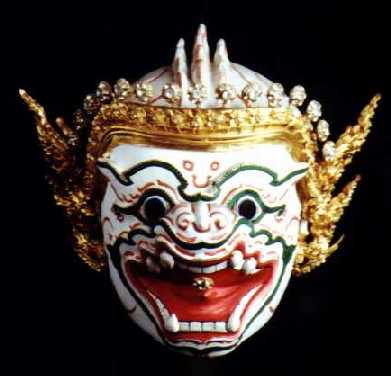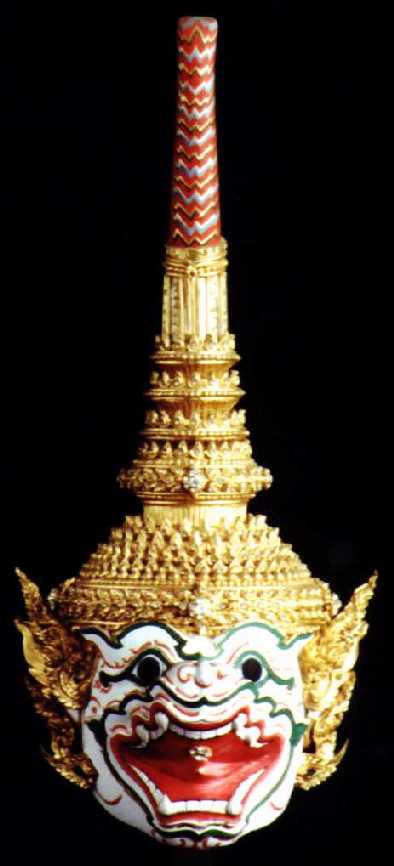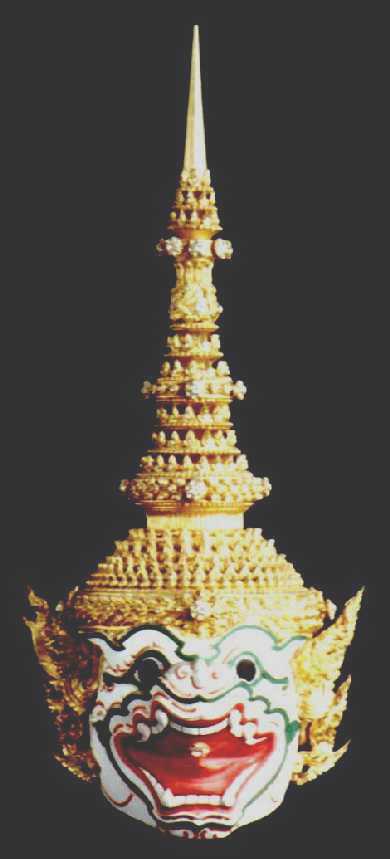The six faces of Hanuman
Back to Articles about Thai Culture
THE SIX FACES OF HANUMAN
Hanuman, the magical white monkey warrior in Rama’s simian army, is probably the best known monkey character in Ramakien, the Thai version of the Indian epic Ramayana. He is featured in several episodes and has become a hero especially for Thai children who recognise him instantly in any artistic representation. In the khon, masked dance drama, Hanuman sports a mask of white colour, wears a diadem, grins with an open mouth and, most important of all, has the symbol of a moon surrounded by stars affixed to the palate of his mouth.
There are indeed other masks for the enactment of Hanuman in the khon performance of the Ramakien, each suiting a particular episode of the story. In this article, six masks are presented. The masks shown in this article are miniature ones made for the purpose of displaying craftsmanship skills and not for performance. They are all made by one craftsman and are from a private collection. The same set are also presented in the CD-Rom entitled “Khon Museum at Suan Pakkad Palace” in the Virtual Reality Format, available only at the Suan Pakkad Palace. – Chakrarot






From left to right:
1. Hanuman the Warrior
2. Hanuman the Almighty
3. Hanuman the Adolescent
4. Hanuman the Crown Prince
5. Hanuman the King
6. Hanuman the Hermit
1. Hanuman the Warrior
The image of Hanuman is typified by this mask. He is white in complexion, with whorls of hair. He wears a jewel studded golden diadem with ear pieces which do not fit behind the ear as they should. His eyes are wide open, attentive and mischievous. His open mouth reveals the symbol of the the moon, surrounded by stars, on the upper palette. One of his magical qualities is the ability to yawn the moon and stars to identify himself as the son of the Phra Phai the wind god.

2. Hanuman The Almighty
When Hanuman displays his full power as a god-incarnate, he becomes a grotesque figure of a huge monkey with six arms and four faces. The khon mask for such imagery also sports four faces, the major one in the front and three smaller ones on the back. This is an example of the Thai ingenuity in the arts. (How craftsmen deal with the ten faces of Thosakanth and the one thousand faces of Sahasdecha will be described in another article.)

3. Hanuman the Adolescent
In a short episode, the adolescent Hanuman frolics in a beautiful garden, not knowing that it is the pleasure garden of Uma, Lord Isvara's wife. She punishes him by putting a spell on him. The spell takes away all his magic powers and most of his memory. The spell can be lifted only if and when Rama recognises him as the son of the wind god. This leads up to the episode in which Rama recognises the hidden power and personal characteristics of Hanuman, strokes him on the back trice and breaks the spell. Subsequently, Hanuman becomes Rama's most entrusted and loyal warrior. The mask here displays even more mischief and wears a lady's diadem with a little more jewelry than usual.

4. Hanuman the Crown Prince
Hanuman manages to infiltrate into Thosakanth's army and to gain his confidence. Thosakanth is overjoyed with what he believes to be a defection and a god-send. He elevates Hanuman to the position of the Crown Prince of Longka and gives him the regalia of Indrachit, the former heir who has been killed in the war. Hanuman proceeds to gain as much knowledge of his arch enemy's secrets as possible before playing havoc on much of the city and fleeing back to Rama's service. In this mask, Hanuman is depicted wearing Indrachit's crown.

5. Hanuman the King
After the vanquish of Thosakanth and the victorious end of the war, Rama is reunited with Sida. They triumphantly return to the throne of Ayodhya. Hanuman is rewarded with the kingship of a vassal state of Ayodhya. He accepts the reward, only to find after a short while that his simian nature is not suited to this high position. For example, he fails to sit still for any length of time. He resigns the kingship and leaves the regal splendour behind for a simple retirement. The mask which represents Hanuman in this episode wears the golden crown of state.

6. Hanuman the Hermit
Finally, Hanuman find peaceful life as a mendicant, living a life of seclusion in the forests. The mask of the hermit Hanuman wears the appropriate headgear.
THE MISSING MASK
There is a seventh mask of Hanuman. When Hanuman is in a pleasant mood, his face glows with pleasure. Thai craftsmen depict this mode by covering the mask with mother-of-pearl which reflects light in seven iridescent colours. A few mother-of-pearl masks exist in museums and private collections, but not yet in this collection.
Chakrarot - June 1999
Back to Articles about Thai Culture
Search for books about Thai Culture and Thai Puppetry
|
||||||